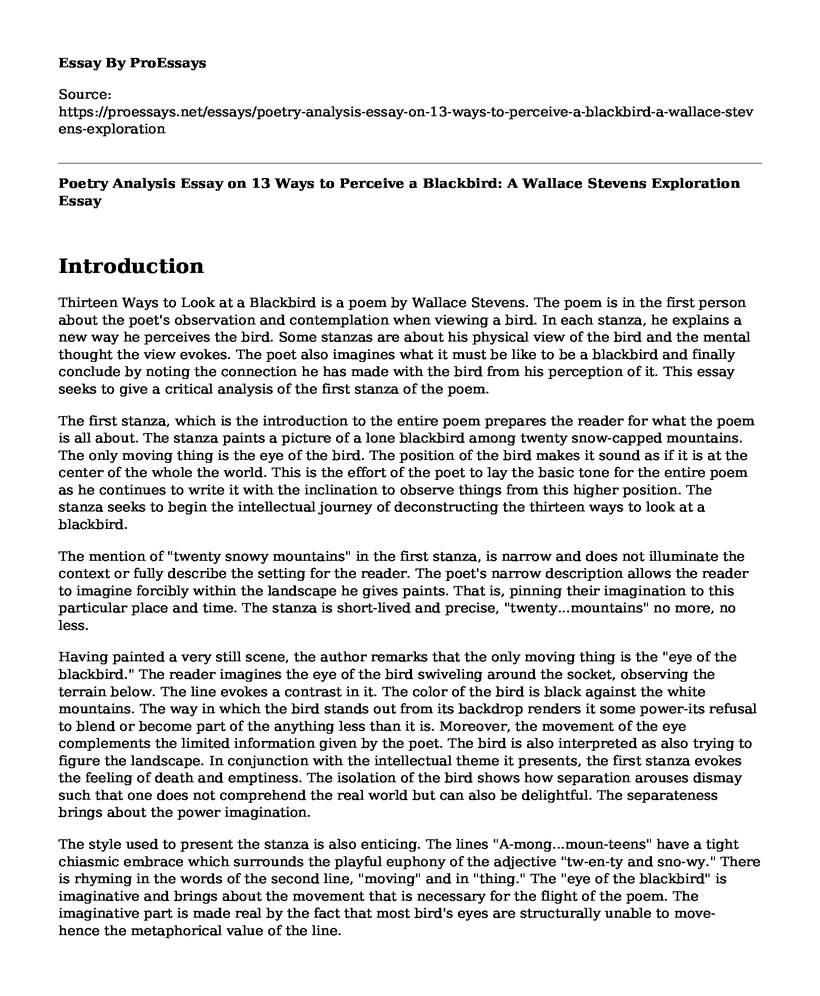Introduction
Thirteen Ways to Look at a Blackbird is a poem by Wallace Stevens. The poem is in the first person about the poet's observation and contemplation when viewing a bird. In each stanza, he explains a new way he perceives the bird. Some stanzas are about his physical view of the bird and the mental thought the view evokes. The poet also imagines what it must be like to be a blackbird and finally conclude by noting the connection he has made with the bird from his perception of it. This essay seeks to give a critical analysis of the first stanza of the poem.
The first stanza, which is the introduction to the entire poem prepares the reader for what the poem is all about. The stanza paints a picture of a lone blackbird among twenty snow-capped mountains. The only moving thing is the eye of the bird. The position of the bird makes it sound as if it is at the center of the whole the world. This is the effort of the poet to lay the basic tone for the entire poem as he continues to write it with the inclination to observe things from this higher position. The stanza seeks to begin the intellectual journey of deconstructing the thirteen ways to look at a blackbird.
The mention of "twenty snowy mountains" in the first stanza, is narrow and does not illuminate the context or fully describe the setting for the reader. The poet's narrow description allows the reader to imagine forcibly within the landscape he gives paints. That is, pinning their imagination to this particular place and time. The stanza is short-lived and precise, "twenty...mountains" no more, no less.
Having painted a very still scene, the author remarks that the only moving thing is the "eye of the blackbird." The reader imagines the eye of the bird swiveling around the socket, observing the terrain below. The line evokes a contrast in it. The color of the bird is black against the white mountains. The way in which the bird stands out from its backdrop renders it some power-its refusal to blend or become part of the anything less than it is. Moreover, the movement of the eye complements the limited information given by the poet. The bird is also interpreted as also trying to figure the landscape. In conjunction with the intellectual theme it presents, the first stanza evokes the feeling of death and emptiness. The isolation of the bird shows how separation arouses dismay such that one does not comprehend the real world but can also be delightful. The separateness brings about the power imagination.
The style used to present the stanza is also enticing. The lines "A-mong...moun-teens" have a tight chiasmic embrace which surrounds the playful euphony of the adjective "tw-en-ty and sno-wy." There is rhyming in the words of the second line, "moving" and in "thing." The "eye of the blackbird" is imaginative and brings about the movement that is necessary for the flight of the poem. The imaginative part is made real by the fact that most bird's eyes are structurally unable to move- hence the metaphorical value of the line.
Conclusion
The essay has analyzed the first stanza of the poem, Thirteen Ways to Look at a Blackbird. The essay has given an interpretation of the stanza. The essay also finds that the stanza set the tone and style that the poet used in the subsequent stanzas.
References
Stevens, W. (1997). Collected Poetry and Prose. New York, NY: Literary of America.
Cite this page
Poetry Analysis Essay on 13 Ways to Perceive a Blackbird: A Wallace Stevens Exploration. (2023, Jan 24). Retrieved from https://proessays.net/essays/poetry-analysis-essay-on-13-ways-to-perceive-a-blackbird-a-wallace-stevens-exploration
If you are the original author of this essay and no longer wish to have it published on the ProEssays website, please click below to request its removal:
- The Rise of Telemachus to Be Worthy of the Title Prince
- Siddhartha Essay
- Cultural Identity in Rodolfo Corky Gonzalez's I Am Joaquin
- Reflection to "A Good Fall" and "Mother Tongue" Essay
- "The Tell-Tale Heart" by Edgar Allen Poe: The Use of Imagery and Literary Devices
- Essay Example on Life's Crossroads: Making Difficult Decisions
- Essay Example on Shakespeare Studies: Examining The True Law of Free Monarchies Using Character Approach







